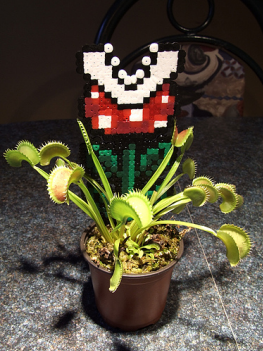By Nadine Moedt (The Cascade) – Email
Print Edition: January 30, 2013
 In Roald Dahl’s Big Friendly Giant, the BFG describes his ability to listen to plant’s voices with his enormous ears. “They is not exactly talking,” he says in his broken English. “But they is making noises. For instance, if I come along and I is picking a lovely flower, if I is twisting the stem of the flower till it breaks, then the plant is screaming. I can hear it screaming, very clear.”
In Roald Dahl’s Big Friendly Giant, the BFG describes his ability to listen to plant’s voices with his enormous ears. “They is not exactly talking,” he says in his broken English. “But they is making noises. For instance, if I come along and I is picking a lovely flower, if I is twisting the stem of the flower till it breaks, then the plant is screaming. I can hear it screaming, very clear.”
Turns out, the BFG wasn’t too far from the truth. Plants are much more observant than you think, so it might be a good idea to smarten up a bit around them.
In his new book, What a Plant Knows, Daniel Chamovitz writes about his findings on plant intelligence. Plants, he claims, can feel, communicate with each other, smell and even remember.
In an interview with Mind Matters, Chamovitz explains the blending of distinction between plant, animal and human DNA. There are “plant specific genes” in people and animals, he says, which are essential for the “timing of cell division, the axonal growth of neurons, and the proper functioning of the immune system.” The parallels between plants and humans, however, go beyond this biology, and raise some questions about the interconnectedness between us and our environment.
While plants can smell, the sense is defined a little differently. An example Chamovitz gives is the process of fruit ripening; if you put a yellow banana in a bag with a green one, the unripe banana will ripen more quickly. This occurs because the ripened fruit releases a pheromone, and the green fruit smells it and starts ripening itself. This happens primarily in nature; a ripening fruit releases a hormone called ethylene, which when sensed by neighbouring fruits stimulates the ripening process, chain reacting until, “more or less in synchrony,” entire orchards and groves ripen.
Memory is another key topic Chamovitz addresses in his book. Plants, he writes, have “short-term memory, immune memory and even transgenerational memory.” A specific example of this considers the Venus Fly Trap. The plant requires two hairs on its leaves to be touched before it closes on an unsuspecting bug; it must, then, have the ability to remember that the first one has been touched. According to Chamovitz this memory lasts about 20 seconds.
I was most interested in Chamovitz’s notes on plant communication. At a very basic level it has been proven that plants can pass messages and warning amongst themselves. If a tree is being attacked by a bug, for instance, it releases a pheromone, which is soon picked up by other trees close by. The neighbour trees begin “making chemicals” to help fight off the imminent invasion. Another example Chamovitz gives is communication through their root system; a plant stressed by drought will communicate its distress to other nearby plants, letting them know to prepare for a water shortage.
Peter Tompkins and Christopher Bird, in The Secret Life of Plants discuss colleague Cleve Backster’s experiments in biocommunication, a term that describes communication between and within species of plants, animals, bacteria and humans. Backster’s most famous experiment involved measuring a plant’s reaction through the polygraph. When a bucket of shrimp was dumped into a boiling pot of water, the plants reaction was one likened to pain. If we allow ourselves to anthropomorphize a bit, we could say that the plant was being compassionate. In another instance, the plant reacted in fear as a match was lit nearby. In an increasingly kooky hypothesis, Backster finds traces of a suggestion that plants may be compassionate and empathetic to other beings’ emotions, or the vibrations those emotions give off. None of his findings were accepted by the scientific world, but his research remains of great interest—albeit an eccentric one—to botany enthusiasts.
So how do these findings impact the way we look at flora? Must we now consider how the hedge feels before we trim it?
Chamovitz sums his thoughts on the changing relationship quite succinctly: “People have to realize that plants are complex organisms that live rich, sensual lives. You know many of us relate to plants as inanimate objects, not much different from stones. Even the fact that many people substitute silk flowers for real ones, or artificial Christmas trees for a live one, is exemplary at some level of how we relate to plants. You know, I don’t know anyone who keeps a stuffed dog in place of a real one!”
The authors of this research are not attempting to revolutionize the way we look at our surrounding vegetation, but rather to bring to our attention the importance of respect; our environment is more closely intertwined with us than we would sometimes like to believe. A little bit of consideration should not be hard to bestow on our fellow living beings.


